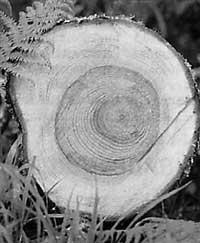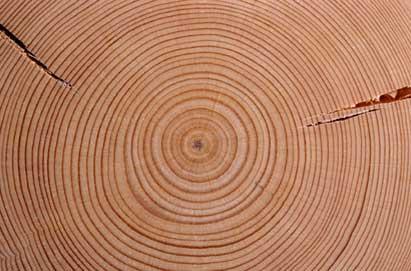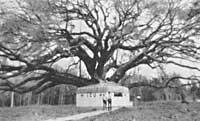Wood in the light of the Moon
2001/10/01 Galarraga Aiestaran, Ana - Elhuyar Zientzia Iturria: Elhuyar aldizkaria
In the tree crop, the tradition about the influence of the Moon is also great. Without knowledge of scientific research, baserritarras and silvicultors follow the traditions communicated orally by previous generations. Among these uses, the Moon has great importance, since the time of the Moon is adequate for planting, pruning, harvesting or cutting of plants.
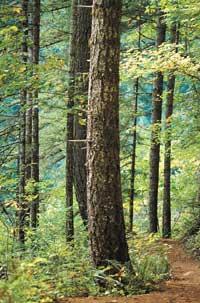
In Euskal Herria are preserved many proverbs and customs on the cutting of trees. For example, many believe that it is convenient to throw the oak in boiling room and in winter. On the other hand, they say that if the beech is cut on the waning moon, the pipee immediately sounds, so it is cast on the crescent moon. In many places, the chestnut, the oak and the walnut appear in a small room, and the alder and the acacia growing. However, these customs do not always coincide with those who look at the appearance of the leaves: Although from the Gipuzkoa Forestry Association it is said that toothed leaf trees should be cut into a missing quarter and others growing, others do not agree.
In addition, some silvicultors also consider the zodiac and follow the indications of Rudolf Steiner. It says that when the Moon passes in front of a constellation, the influence of this constellation on the plants increases, so we must take into account the four elements (fire, water, earth and air).
But the zodiac around it is new, but the same does not happen with the calendar established by the Church. The introduction of certain customs of the priests in the work of hamlet and forest has caused that on more than one occasion there is a contradiction between religious dates and lunar periods (Good Friday, always full moon).
Faced with these contradictions, expert Jakoba Errekondo has his opinion. In his opinion, aside from religion and beliefs, the use that is intended to give to wood determines when trees should be cut. A specific use is often given to each tree species. Therefore, it is usually said that this tree should be cut in a specific moon period. But if you want to use the same tree for something else, it may be convenient to change the time to throw it. Therefore, the beech is thrown in August and the crescent moon because you want to make steels or have them always wet. And, like oak, trees that are usually cut into the waning moon are usually necessary for construction or for long duration.
In fact, the Moon affects the circulation of the sweat of the trees. Sweat is an aqueous substance that the roots absorb from the soil and is rich in nourishing elements. It rises from the tubes of an inner layer of the trunk to the leaves, where photosynthesis occurs and becomes a dead sweating that descends through the superficial pipes of the trunk.
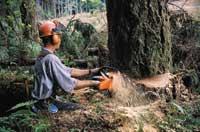
Depending on the amount of sweat that has the trunk, the wood has some characteristics or others. In Crescent Moon the tree sweats a lot and the wood will be flexible, light and wet. In small room, the sweat circulation is in the opposite direction and low from the trunk to the roots, so the wood will be hard, dry and resistant. The more wood is soaked, the greater the risk of fungal and xylophage attacks, since the trunk contains the nutrients and moisture needed by these harmful microorganisms. Thus, if the tree is expelled at the time of less sweating, the sustainability of the wood is guaranteed in a natural way. Therefore, the time to pull will be chosen knowing the use you want to give to wood, since the lunar period requires some characteristics or others.
On the other hand, today the sawmills work without cuts and need trunks in all times, so the Moon is not seen the same as before. The waste by species and use would mean an increase in the process, among other things, for the need to prepare warehouses in an express way and for the difficulty of the organization. In addition, for the manufacture of paper or agglomerates, for example, no matter the amount of sweat or the humidity of the trunk. Consequently, the radiata pine is poured throughout the year.

In addition, the scientific research carried out does not coincide, so, in the absence of clear conclusions, each one follows its own criterion. For example, in the journal published in November last year by the Swiss Forestry Association, different studies on tree cutting are released. In these studies, the characteristics of the trees cut in the different lunar periods are compared, resulting that the characteristics of the wood do not experience significant variations depending on the time of the logging. According to the researchers, although the customs that have lasted for hundreds of years make think otherwise, in the creation of the old laws based on customs other actors participated: the climate, the geographical location, the interests of the authorities, etc.
However, apart from experience and traditions, there are other scientific studies that obtain a totally contrary result. It seems that the decisive conclusions on the incidence of the Moon will require further research. Meanwhile, we look forward to the answer to this question: To what extent is the force of the Moon?

Gai honi buruzko eduki gehiago
Elhuyarrek garatutako teknologia




